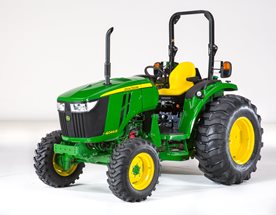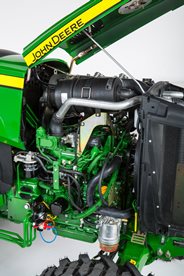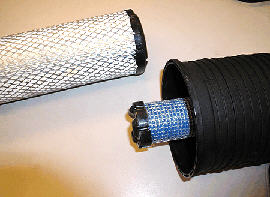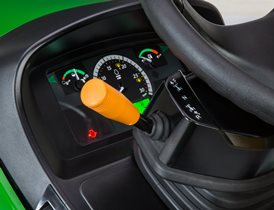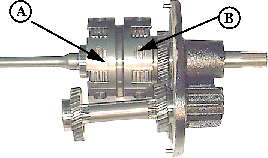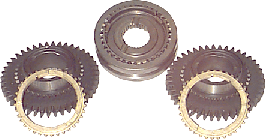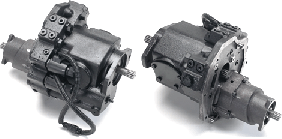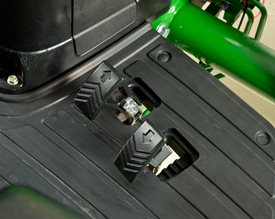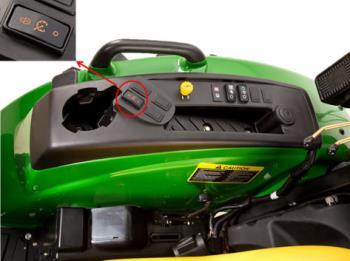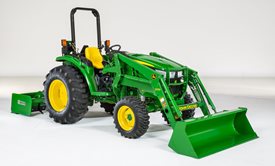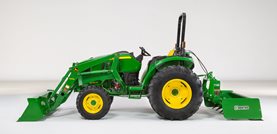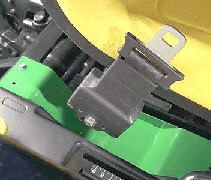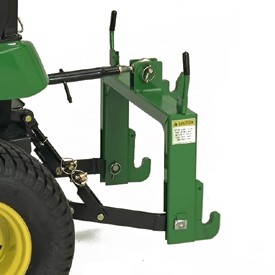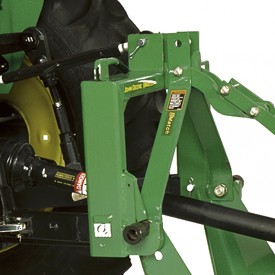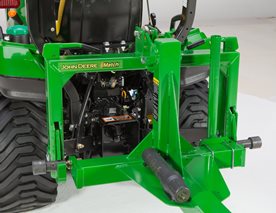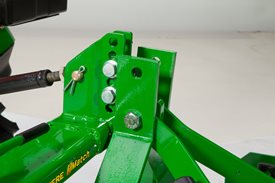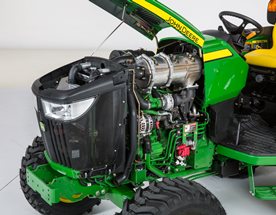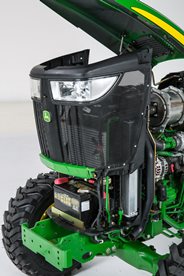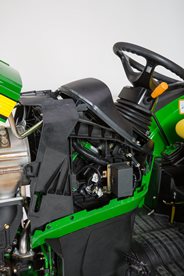0% APR fixed rate for 60 months1
4044MCompact Utility Tractor
- Powerful and reliable Yanmar Diesel Engine
- PowrReverser™ or eHydrostatic Transmission options
- Standard 4-wheel-drive
- Assembled in Georgia
- Category 1, 3-point hitch compatible with iMatch™ Quick-Hitch
For pricing and additional discounts, see your local John Deere Dealer.
The Compact Utility Tractor Composite Hood
We design our Compact Utility Tractor Hoods for the harsh, extreme environments they are intended to be used in. We have developed them to be tough and durable. How tough? See what happens when you drop an 8.8 lb (4 kg) Shot Put on one of our composite hoods in – 20 F. (- 28.89 C) temperatures. Don’t do that with a metal hood.
Specs & Compare
Add Model
| Specs & Compare | ||||
|---|---|---|---|---|
| Select up to 4 models to compare specifications | John Deere 4044M Compact Utility Tractor |
Key Specs
| Engine power (gross) | SAE J1995 rated power: 31.7 kW 42.5 hp 43.1 PS at 2600 rpm |
|||
|---|---|---|---|---|
| Power take-off (PTO) power | PowrReverser™ transmission: 25 kW 33.6 hp eHydro™ transmission: 24.1 kW 32.3 hp Per SAE J1995 |
|||
| Steering hydraulics | 23.5 L/min 6.2 gpm |
|||
| Implement hydraulics | 42.3 L/min 11.2 gpm |
|||
| Hitch type | Category 1 | |||
| Lift capacity, 24-in. behind link arms | 1135 kg 2500 lb |
|||
| Standard transmission; forward/reverse | PowrReverser transmission | |||
| Cruise control | Optional | |||
| Approximate shipping weight (open-station; cab) | Open operator station (OOS): 1705 kg 3759 lb Cab: Not applicable |
|||
| Wheelbase | 185.5 cm 73 in. |
Engine
| Family | EYDXL2.19NDA FYDXL2.19NDA GYDXL2.19NDA |
|||
|---|---|---|---|---|
| Manufacturer | Yanmar® | |||
| Engine model | 4TNV88C-MJT | |||
| Engine power (gross) | SAE J1995 rated power: 31.7 kW 42.5 hp 43.1 PS at 2600 rpm |
|||
| Power take-off (PTO) power | PowrReverser transmission: 25 kWh 33.6 hp eHydro transmission: 24.1 kW 32.3 hp Per SAE J1995 |
|||
| Rated engine speed | 2600 rpm | |||
| Type | Diesel | |||
| Injection pump type | High pressure common rail direct injection | |||
| Aspiration | Natural | |||
| Emissions compliance | Final Tier 4 | |||
| Cylinders/displacement | 4 / 2.189 L 4 / 133.5 cu in. |
|||
| Number of cylinders | Four | |||
| Cylinder liners | Cast-in-block | |||
| Bore and stroke | 88x90 mm 3.46x3.54 in. |
|||
| Compression ratio | 19.1:1 | |||
| Lubrication | Pressurized | |||
| Cooling system | Liquid | |||
| Air cleaner | Dual element | |||
| Engine torque at rated speed | 116 Nm 85.6 lb-ft |
|||
| Fuel tank capacity | 56.9 L 15 U.S. gal. |
Electrical
| Battery size | 770 CCA | |||
|---|---|---|---|---|
| Alternator (12-V) | 75 amp | |||
| Starter size | 2 kW 2.68 hp |
Fuel system
| Type | High pressure common rail direct injection | |||
|---|---|---|---|---|
| Fuel consumption |
Transmission
| Standard transmission; forward/reverse | PowrReverser transmission | |||
|---|---|---|---|---|
| Optional transmission; forward/reverse | eHydro transmission | |||
| Left-hand reverser | PowrReverser transmission only | |||
| Transmission gear ranges | 12F/12R PowrReverser Infinitely-variable, three range |
|||
| Final drive | Planetary | |||
| Brakes | Multi-plate wet disc | |||
| Steering | Hydrostatic power steering | |||
| Clutch, wet/dry | Wet | |||
| Clutch disk diameter wet clutch | 129 mm 5.08 in. |
|||
| Axle capacity | Front 1600 kg 3528 lb Rear 2400 kg 5292 lb |
|||
| Creeper | No | |||
| Cruise control | Optional | |||
| Differential lock | Yes | |||
| Drawbar maximum vertical load |
Hydraulics
| Type | Open center | |||
|---|---|---|---|---|
| Pump rated output | Steering 23.5 L/min 6.2 gpm Implement 42.3 L/min 11.2 gpm 65.8 L/min 17.4 gpm |
|||
| Pump type | Single gear | |||
| Maximum operating pressure | ||||
| Draft control sensing | Position control | |||
| Remote control valves available | Up to six rear remotes |
3-point hitch
| Type | Category 1 | |||
|---|---|---|---|---|
| Lift capacity, 24-in. behind link arms | 1135 kg 2500 lb |
Power take-off (PTO)
| Standard | Independent 540 rpm at 2600 rpm |
|||
|---|---|---|---|---|
| Optional | ||||
| Control | Position | |||
| Clutch | Wet disc | |||
| Brake (for mid and rear PTO) | ||||
| Engagement method |
Fluid capacities
| Crankcase with filter | 5.3 L 1.4 gal. |
|||
|---|---|---|---|---|
| Transmission and hydraulic system | 47.3 L 12.5 gal. |
Final drive
| Type | Planetary | |||
|---|---|---|---|---|
| Differential lock | Yes |
Operator station
| Rollover protective structure | Type Foldable Yes |
|||
|---|---|---|---|---|
| Platform - flat/straddle | Flat | |||
| Gear shift location - console/floor | PowrReverser - Left-hand side |
Cab
| Compliance | ||||
|---|---|---|---|---|
| Visibility | ||||
| Air conditioning, temperature differential | ||||
| Doors | ||||
| Noise rating | ||||
| Seat equipment |
Dimensions
| Height | ||||
|---|---|---|---|---|
| Wheelbase | 185.5 cm 73 in. |
|||
| Front axle clearance | 35.1 cm 13.8 in. |
|||
| Turning radius with brakes | 2.8 m 9.19 ft |
|||
| Turning radius without brakes | 3.0 m 9.84 ft |
|||
| Limited slip differential | ||||
| Approximate shipping weight (open-station; cab) | OOS: 1705 kg 3759 lb Cab: Not applicable |
Tires
| Front | Farm - 8-16 Turf - 27x10.5-15 or 27x12LL-15 Industrial - 10-16.5 |
|||
|---|---|---|---|---|
| Rear | Farm - 13.6-28 Turf - 44x18-20 or 22.5LL-16.1 Industrial - 16.9Lx24 |
|||
| Front tread range | 148.1 cm 58.3 in. |
|||
| Rear tread spacing | 137.2 cm 54 in. |
Miscellaneous
| Toolbox | ||||
|---|---|---|---|---|
| Tilt steering wheel | ||||
| 12-V Outlet |
Additional information
| Date collected |
|---|
Shop and Buy
Maintenance and Support
You May Also Be Interested In
*The engine horsepower information is provided by the engine manufacturer to be used for comparison purposes only. Actual operating horsepower will be less. Offers valid in the United States. Prices in U.S. dollars.
1Offer valid on qualifying purchases made 02 December 2025 through 02 February 2026. Subject to approved installment credit with John Deere Financial. Down payment may be required. Average down payment is 10%. $16.67 per month for every $1,000 financed. 0% APR for 60 months available based on dealer participation. Taxes, freight, setup, insurance, fees, and delivery charges could increase monthly payment. Sales to government agencies, company direct sales or other individuals or entities participating in any John Deere Special Discount Program or Rental Business Program are not eligible. Available at participating U.S. dealers. Prices and models may vary by dealer. Offer available on new equipment and in the U.S. only. Prices and savings in U.S. dollars.
Images of equipment models may be digitally or AI generated, are for illustration purposes only, and are subject to change. Equipment models shown are typically base models and may not reflect the actual product, features, options, or attachments. Equipment availability may be limited. See your John Deere dealer for additional information.


























